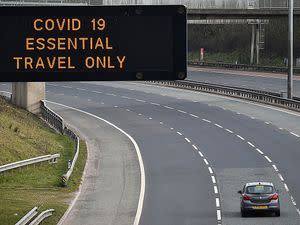Coronavirus: SAGE recommended 'circuit breaker' lockdown to ministers three weeks ago
Minutes from a 21 September meeting of the Scientific Advisory Group for Emergencies (SAGE), published on the government website on Monday night, showed that a short period of lockdown was at the top of a list of measures to be considered for "immediate introduction".
SAGE, which has provided scientific and technical advice to ministers throughout the COVID-19 pandemic, warned that "not acting now" would result in a "very large epidemic with catastrophic consequences" amid a rising number of coronavirus cases.
The group warned that "a package of interventions will need to be adopted to prevent this exponential rise in cases" and "single interventions are unlikely to be able to reduce incidence".
At the top of a shortlist of "non-pharmaceutical interventions that should be considered for immediate introduction" was a "circuit-breaker".
The SAGE minutes described this as a "short period of lockdown to return incidence to low levels".
Other measures SAGE recommended for consideration included advice to work from home for all those that can, banning people mixing with other households, the closure of all bars, restaurants, cafes, indoor gyms and hairdressers, and for all university and college teaching to be online unless essential.
The minutes also stated that the NHS Test and Trace system was "having a marginal impact on transmission at the moment".
"Unless the system grows at the same rate as the epidemic, and support is given to people to enable them to adhere to self-isolation, it is likely that the impact of Test, Trace and Isolate will further decline in the future," the document added.
SAGE recommendations NOT included in three-tier system
A circuit-breaker (short period of lockdown) to return incidence to low levels
Closure of restaurants
Closure of personal services such as hair and beauty salons
Higher education classes to be online only
SAGE recommendations implemented in some areas
No mixing of households indoors and outdoors, including in private gardens
Pubs and bars to close
Gyms and indoor exercise activities to close
The SAGE meeting on 21 September came after Health Secretary Matt Hancock had described a "circuit-breaker" lockdown as the "last line of defence" against rising COVID-19 infections.
On 22 September, Prime Minister Boris Johnson announced a 10pm curfew for pubs, bars and restaurants in England, while he also told people to work from home again if they can.
On Monday, Mr Johnson confirmed he was "simplifying" local lockdown restrictions with a new three-tier system.
However, he stressed he did not believe another national lockdown would be the "right course".
Labour's shadow health secretary Jonathan Ashworth accused the government of having ignored experts and criticised the publication of the SAGE minutes after Mr Johnson had faced questions at a Downing Street news conference.
"The revelations in this paper are alarming," he said.
"The fact that the prime minister chose to publish it an hour after his press conference is yet more evidence that he is treating the British people with contempt.
"Labour warned earlier that the restrictions announced by the prime minister may not be sufficient.
"The government now needs to urgently explain why it ignored its own scientists and what it will be doing to get control of the virus."
Analysis: Documents expose gaping gaps in relationship between government and scientists
By Rowland Manthorpe, technology correspondent
Once again, the government is being criticised for not "following the science".
This was always an unrealistic expectation - albeit one the government set for itself - so it is hardly surprising it has not been met.
Nevertheless, the SAGE minutes expose gaping gaps in the relationship between the government and its expert advisors.
SAGE urged ministers to act quickly with tough measures across the entire country. The next day, the prime minister did follow one piece of its advice, calling on people to work from home.
Aside from that, the only national measure introduced in the three weeks after 21 September was a 10pm curfew for hospitality, a measure the SAGE minutes describe as "likely to have a marginal impact."
Does this mean the economic argument won out over the case for public health? Perhaps. But the divide between these goals is often overstated; after all, if the outbreak dies down, then pubs can reopen.
To understand what really happened, we need to know more about how advice is presented.
Why isn't SAGE asked to look at other factors, such as the impact of restrictions on healthcare?
Why weren't the problems it observed with Test and Trace raised earlier?
What role does the Joint Biosecurity Committee play in the government's decision-making?
Right now, it seems as if the government and its scientific advisors are working to different plans.
Whether or not you agree with SAGE's conclusions, that can't be to anyone's benefit.

 Yahoo News
Yahoo News 




